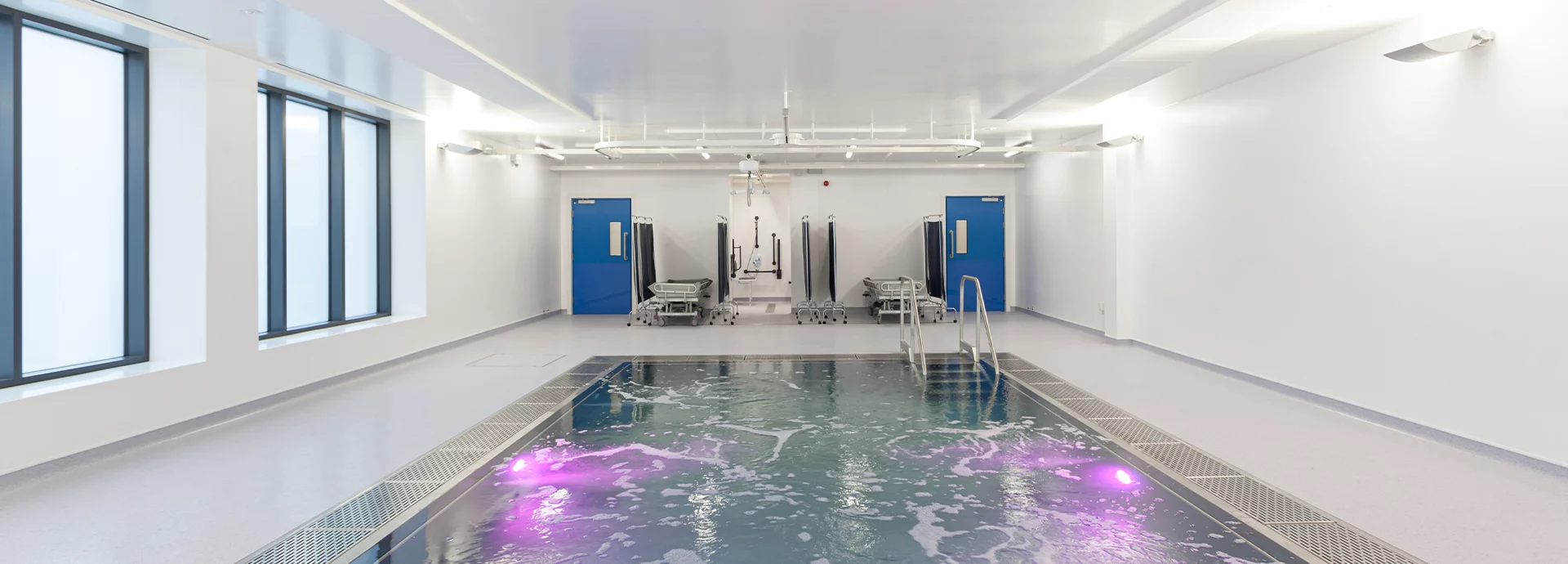Determining the Optimal Size and Depth
The size and depth of a hydrotherapy pool should be carefully considered to meet the needs of students, carers, and therapists. A standard size of 6 metres by 4 metres allows ample space for multiple users, typically accommodating two students and two carers at any one time. However, larger schools or those with a high number of wheelchair users may require more extensive facilities.
Depth is also a crucial factor. For younger children, a shallower pool is preferable to allow them to stand and move safely. For older students and those requiring assisted movement, a greater depth may be necessary to enable full-body support and floatation. Adjustable floors can be an excellent solution, allowing staff to modify the depth based on the needs of different users.
Ensuring the Highest Standards of Hygiene and Infection Control
Hydrotherapy pools in SEN schools are used frequently, so maintaining high standards of hygiene is imperative. Traditional tiled pools can pose a hygiene risk as grout lines may harbour bacteria. A more effective alternative is a stainless steel hydrotherapy pool, which provides a non-porous surface that is resistant to bacterial growth and much easier to clean.
Additionally, an efficient water filtration system is essential. Water should be filtered and treated every 60 minutes to maintain clarity and prevent the build-up of harmful bacteria. Schools should also implement strict cleaning protocols, including regular water testing and staff training on hygiene management.
Integrating Sensory Features for Enhanced Therapy
Many SEN students benefit from multisensory stimulation, which can be incorporated into hydrotherapy pool design. Sensory features such as:
- Colour-changing LED lighting to create a calming or stimulating atmosphere
- Air jets and bubble mats to provide gentle pressure and relaxation
- Overhead rain showers to enhance tactile sensory input
- Water fountains and interactive elements to encourage engagement and movement
For students with autism or sensory processing disorders, additional features such as ceiling projectors displaying soothing images and blackout blinds to control lighting conditions can help create a more comfortable and personalised therapeutic environment.
Implementing Effective Evacuation and Safety Procedures
Safety is paramount when designing hydrotherapy pools for SEN schools. One of the best ways to enhance safety is by designing the pool partially above ground. This ensures that students and carers can transfer easily onto evacuation chairs or other equipment in the event of an emergency. It also minimises the risk of accidental falls into the water.
Having a pool flush with the floor level, is also popular as helps for evacuation purposes and means steps aren’t needed to go up before going down into the pool so saves space.
Other essential safety features include:
- Non-slip flooring around the pool area to prevent accidents
- Temperature-controlled water to provide a comfortable and safe environment
- Clearly marked emergency exits and trained staff to assist with evacuation procedures
Providing Hoist and Transfer Systems for Accessibility
For students with mobility impairments, a well-designed hoist system is essential to facilitate safe and dignified transfers into and out of the pool. An overhead X-Y hoist system allows carers to move students seamlessly from the changing area directly into the water without unnecessary handling or discomfort.
An integrated ceiling track extending from the pool to the changing rooms ensures smooth and effortless transitions, helping to maintain students’ dignity and comfort throughout the hydrotherapy session.
Additional Considerations for a Fully Functional Hydrotherapy Facility
Beyond the pool itself, the surrounding facilities play a crucial role in ensuring accessibility and comfort. SEN schools should also consider the following:
- Spacious and well-equipped changing rooms, including height-adjustable changing benches and hoists
- Climate-controlled pool environments to ensure warmth and comfort for students with sensory sensitivities
- Acoustic considerations, such as soundproofing, to minimise noise levels and create a calm atmosphere
- Viewing areas for teachers and carers to observe students safely from a distance
Conclusion
Designing hydrotherapy pools for SEN schools requires careful planning and attention to detail to create a safe, inclusive, and therapeutic environment. By considering factors such as pool size, hygiene, sensory features, safety procedures, and accessibility, SEN schools can develop a hydrotherapy facility that maximises the physical and emotional benefits for students.
FAQs for Hydrotherapy Pools in SEN Schools
What are the benefits of hydrotherapy pools for SEN students?
Hydrotherapy pools provide therapeutic benefits such as improved mobility, muscle relaxation, and sensory stimulation, helping students with physical and developmental disabilities.
What size and depth should a hydrotherapy pool be?
A standard hydrotherapy pool is around 6m x 4m, accommodating multiple users. Adjustable floors can help modify depth based on student needs.
How can SEN schools maintain hygiene in hydrotherapy pools?
Using stainless steel pools, efficient filtration systems, and regular water testing ensures high hygiene standards and prevents bacterial growth.
What sensory features can be integrated into hydrotherapy pools?
Features like color-changing LED lights, air jets, bubble mats, and overhead rain showers enhance sensory stimulation and relaxation.
What safety measures should be in place for hydrotherapy pools?
Effective evacuation procedures, non-slip surfaces, and trained staff ensure student safety during hydrotherapy sessions.



